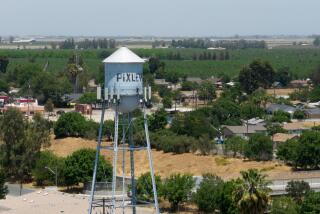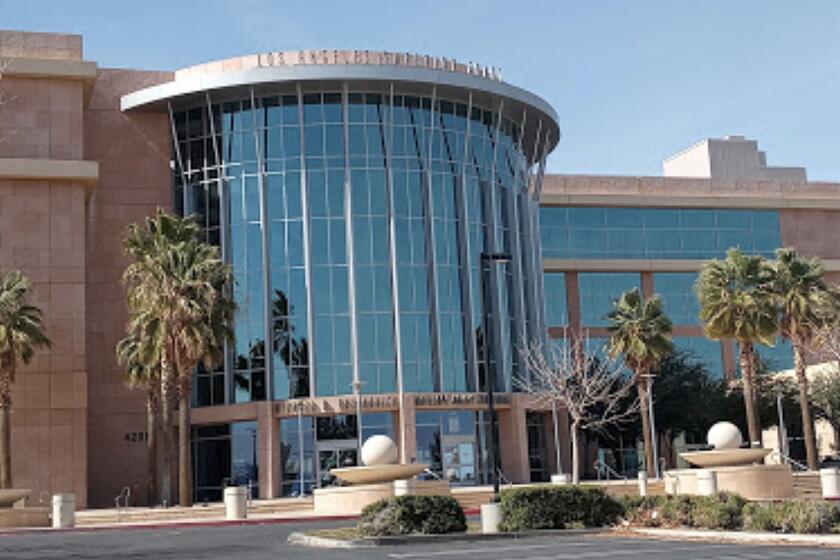THE DROUGHT : Reclaimed Water May Be Answer for Thirsty Fields
- Share via
As water supplies shrink, Ventura County officials have begun looking at a virtual sea of reclaimed water to float them out of the drought.
At least four water-reclamation projects are under review. They could supply a steady stream of treated waste water to nurture farmers’ fields and keep golf courses and parks from turning brown.
It is estimated that reclaimed water projects could supply Ventura County with up to 37,000 acre-feet of water a year, which is 9% of the county’s total annual demand.
“People are very aware of the drought and the significant impact reclaimed water has on keeping public places green without having to give something up to do it,” said David Burkhardt, assistant manager for the Ventura County Regional Sanitation District.
Already, waste water that once was discharged by local sewage plants into the oceans and streams is being put to an increasing number of uses.
In Lake Sherwood, the Triunfo County Sanitation District sells 6,000 acre-feet of treated waste water each year from the Tapia Wastewater Reclamation Facility to nearby golf courses. An acre-foot is equivalent to about 326,000 gallons of water, enough to supply a family of four for a year, officials said.
For the past 10 years, the city of Ventura has been recycling 820 acre-feet of waste water annually to irrigate two city golf courses and parks near the treatment plant. And in Camarillo, the city has for the past 10 years provided a portion of its waste water to Smith’s Ranch, a 400-acre vegetable farm that grows crops used in processed foods.
Additional water reclamation projects planned in Thousand Oaks, Moorpark and the Oak Park-North Ranch area could supply millions of gallons more water each day, Burkhardt said.
In the case of the Oak Park-North Ranch facility, reclaimed water would completely replace the potable water used to irrigate the golf course. And in Moorpark, Ventura County Waterworks District No. 1 is polling 60 agricultural customers to determine what the demand for water will be, manager Reddy Pakala said.
But reclaimed water will never completely replace water intended for drinking and farming. Because of health concerns, reclaimed water, even if it is subjected to rigorous treatment to remove all the bacterial impurities, is restricted for use only on certain crops.
In the past, even farmers allowed to use it have not been enthusiastic about reclaimed water supplies, citing health concerns.
“The big thing about reclaimed water is health,” said Dave Pommer, who manages the 900-acre lemon orchard owned by U.T.T. Development. Pommer also is a board member of the Assn. of California Water Agencies and the Ventura County Farm Bureau.
“If they can clear up the health issue, I’m sure farmers will use it,” Pommer said.
Tertiary treatment removes most of the impurities and bacteria in sewage. But it leaves in some of the nitrates that would actually be beneficial to farmers who use fertilizers for their crops, said Bob Quinn, an engineer for the county Water Resources Department. But some farmers still object to the very idea of using waste water, no matter how much it is cleaned up.
Another problem in expanding the use of treated waste water is the up-front costs of building reclamation facilities and installing pipelines to distribute the water.
At Lake Sherwood, reclaimed water costs $436 an acre-foot, nearly 50% more than the highest prices farmers in Ventura County pay for irrigation water.
“Farmers can’t buy water at $436 per acre-foot and stay in business. Nobody would be able to buy the crops they grow,” Burkhardt said.
Some experts believe that, as the cost of imported water rises, reclaimed water could become more attractive.
The biggest selling point that proponents of reclaimed water make is about the availability of the supplies. Households dump the same amount of sewage into the sewer system year-round, and reclaimed water can be counted on when other supplies are low.
“The supply of reclaimed water is very steady. The number of houses doesn’t change very fast,” Burkhardt said.
There is so much demand on Triunfo’s reclaimed water supplies that the agency is planning the construction of a reservoir somewhere in the Malibu Creek drainage basin to store water for use during periods of high demand.
Preliminary studies indicate the dam would cost about $18 million to build and would likely require the preparation of an environmental impact report, Burkhardt added.
Still, agency officials are looking for a site for the dam and have identified at least two in Ventura County. One is near the Ahmanson Ranch and another site straddles the Ventura-Los Angeles county line at Donnell Ranch south of Lake Sherwood.
“It is a project that would make a lot of water available to customers by 1995,” Burkhardt said.
More to Read
Sign up for Essential California
The most important California stories and recommendations in your inbox every morning.
You may occasionally receive promotional content from the Los Angeles Times.










